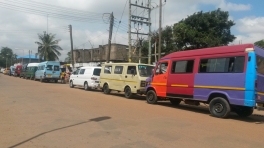
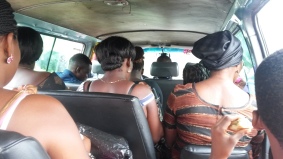
Getting around is one of the most important aspects of everyday lives. Depending where you live or work around the world, your transportation could include walking, taking a bus/train, riding a bike, driving (motorcycle or car), or even flying. In Ghana, the main method of transit for those who don’t have their own vehicle is the trotro (or what I sometimes just call “the tro”). The trotro isn’t unique to Ghana, but is common in many African countries with different names and states of disrepair (it’s called a Taxi in South Africa and a Mutatu in Kenya). So here’s a helpful guide to anybody encountering this weird and wonderful system – it’s definitely an experience everyone should try!
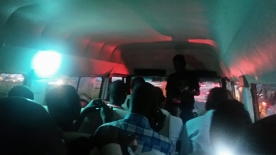
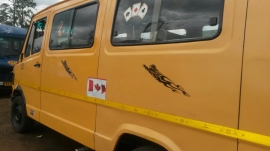
Trotro – A trotro is a privately owned minibus that is used to get around within a city or between cities. Although there is a public bus system (called Metro Mass Transit), I’ve only ever seen about 50 of those big orange buses in my whole time here (and I see hundreds of trotros each day – I would estimate that more than half of the traffic in Accra is made up of taxis and trotros). Apparently MMT is cheaper and runs the same routes but it also breaks down a lot and is unreliable. Trotros on the other hand are still cheap but are also plentiful. They can take you anywhere in the city, and although they are run by private drivers, the prices are set. It never costs more than 2 cedis (60 cents) within the city for one ride, but it does cost more if you leave from the station that if you pick up a ride along the road.
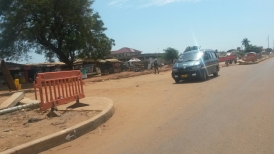
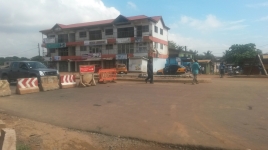
This is the stop where I get my tro in the morning (Palm Wine Junction). Due to construction, different parts of the road are open on different days since I’ve been here.
Driver – The driver is the guy who drives the route. He communicates with the mate to know when he should stop. However, deciding when to go is up to him (I’ve never seen a woman driver). When the mate gets out at a stop to solicit more passengers, the driver will often creep forward. After awhile, when the driver doesn’t feel like waiting anymore, he just starts driving. Then the mate runs to the car, jumps in, and slams the door after were already back on the road. The drivers love the horn, and are responsible for swerving around the millions of potholes. They also often call out the destination of the tro, though not with as much excitement as the mate.


Mate – The mate sits in the seat closest to the sliding door and is responsible for recruiting new passengers, letting off current passengers at the appropriate stop, dealing with the money, and communicating with the driver. Some mates are better than others, but the best mates are very impressive. A trotro might hold about 20 passengers, and the mate can take cash and destinations from each person at the beginning of the trip and remember how much change each person gets, plus their destination. They usually just have a wad of cash in their hands, but some use a small purse or fanny pack instead. They also try to fix the trotro if it breaks down (above).
The trotros are often in very rough shape. The white in the picture below isn’t the floor, it’s a hole where you can see the road passing by. Often the big sliding door doesn’t close properly, so the mate holds it closed while driving down the street. One time the guys in the front cabin had to get out, they flipped up the seat, and oil started spurting everywhere. They grabbed a bottle, poured in more oil, slammed down the seat to close it (I guess there’s no cap or anything), and then we were on our way! This means that tros sometimes don’t start (the engine stalls and they need to be pushed) or sometimes they randomly die while you’re on them (which has only happened to me a few times). Sometimes they are able to repair it quickly, and other times you must find another way to your destination. Below is a picture of the trotro repair areaa I pass everyday on the way to work.
Getting around a tro station is sometimes a bit hectic. They’re filled with women selling food, hawkers, mates yelling the destination of their tros, passengers walking around, and of course trying to avoid getting hit by the vehicles themselves.
Each trotro driver also likes to decorate the inside and outside of their vehicle. This might include stickers on the window, hanging little key-chains on the windshield, and most importantly, bumper stickers and big slogans across the back windows.
Before I got to Ghana, I heard trotros were like the wild west, anything goes… full of screaming babies, live goats, and way too many people. Perhaps this is the way it used to be, but a few years ago all of the trotros were organized and rules were put in place. I believe that’s why there’s a very specific number of people that fit in a tro, and they never really deviate from that number (it’s even posted on a sticker outside the front of the vehicle). Most vehicles in the city are either 12 (3 rows of 3 across, plus 3 in the front cab) or 23 people (5 rows of 4 people, plus 3 in the front) – including one mate and one driver.
This is the stop where I sometimes catch my trotro home from work (if I’m going to the gym or grocery shopping). The area is called Madina (or Zongo Junction).
Getting on a Trotro – This is very difficult if you don’t know what the final destination of your trotro is. Try to ask somebody before departing on your adventure. Guide books will tell you tros have no routes and schedules but this is simply untrue. They may only leave when they’re full but they have very specific routes. Also, if you’re catching a tro from the station, every person in the station will be able to direct you towards the right tro for your destination, as they always leave from the same spot in the lot. The big muddy area may not look organized, but each vehicle has a spot based on where it’s going. When one vehicle fills up, another empty one will come fill it’s space. Once you are directed to the right area, you find the man who is yelling your destination and making the appropriate hand gesture (like “circ, circ, circ, circle-ease” or “Accra-cra-cra”). This also gets easier over time… Once you find the right tro, you get in. There are usually 3-4 bench seats which each hold 2-3 people (it’s obvious by the length of the seat). Usually people fill from the front to the back, but if it’s totally empty you can sit anywhere (window seats are more prized). After all the benches are full, the flip-down seats in the aisle come down, starting from the back to the front. The mate sits in the first or second flip-down seat close to the door. Then the mate collects the money (from front to back). If you get on at a station the price is often fixed, if you get on along the road at a stop they will want to know where you’re going to figure out your change. Usually they don’t give your change right away, and sometimes will take all the money at the beginning and remember where all the change goes in the end… it’s actually amazing! So don’t be scared if you don’t get change right away. Then sit back, and enjoy the ride!
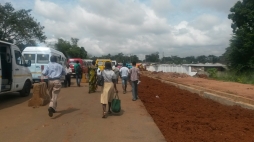
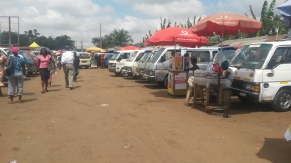
This is “Tech 7” or “37 Military Hospital”, the main tro station by my house, and where I often have to stop on the way to work. Normally the line to get in the station is so long in the morning that everybody gets off on the road and has to walk to the station.
Getting off a trotro – Getting off a trotro can be difficult, but it gets easier over time once you know the city. Sometimes the mate will call out the next few stops and it’s up to you to alert him if you want to get off there. Conversely, if the mate doesn’t ask, you can say “Hey mate, bah-stop (spelling?)” Or “Mate – *insert stop name*”. Asking other passengers for help with knowing where to get off is also totally acceptable. Right before the stop, the mate will hit the outside of the tro with his hand through the window, which signals the driver the stop. If the tro is full and you’re in the back you often have to alert the people around you that you are getting off. Sometimes those on your bench will get off too and get back on after you’ve exited (especially if they’re in the aisle seats). Sometimes people are lazy and just sit there so you have to squeeze past their knees and try not to step on any feet! The mate will hold your stuff (including children!) while you get out if you have trouble. Grab onto something while getting out (because the step is small and you might fall off), and try not to get any loose clothing stuck on jagged seats. Also, look before stepping out, as there may be a bike passing or a large ditch close-by you could fall into!
While on the trotro you can attend a church service (mandatory church – not my favourite – where a preacher gets on and just start randomly talking about God, often in Twi), or buy anything you want from the vendors (optional). It’s actually super convenient on the way to work… you can buy almost anything. My favourite things are phone credit, pure water (a sachet of cold drinking water), and plantain chips. However, you can also buy other snacks, and random things like full-length mirrors, scales, maps, and even wall clocks.
So if you’re in Ghana, take a ride on a tro! It might be hot, cramped, and long, but it’s sure to be full of adventure!
—–
This blog is one in a series about transportation in various countries. To read similar blogs, check out the links below:
Bangladesh (Dhaka) – Getting Around in Dhaka – Rickshaws, Buses, Cars, and CNGs (coming soon)
Bangladesh (Dhaka) – The madness that never ends! – Traffic in Dhaka (coming soon)
Nepal (Kathmandu) – How to get around in Kathmandu – Transport in Nepal (coming soon)






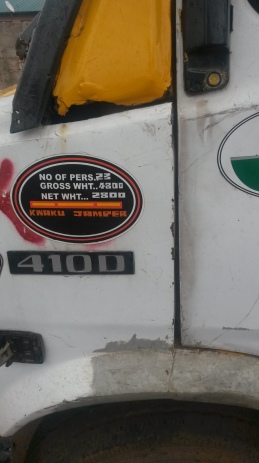
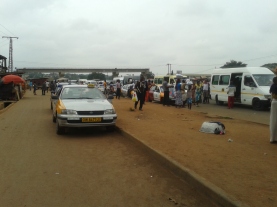
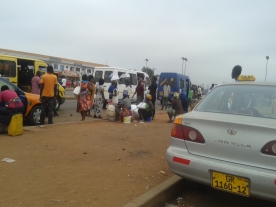

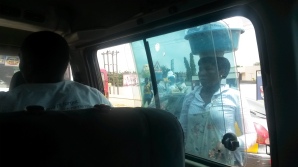
The Amanda’s guide to Ghanaian life! In de smaller town around Cape Coast they keep on adding people, two weeks a ago I was with 21 people in a 14 person tro.
LikeLike
Hey Maarten, good to know! I definitely like the Accra system!
LikeLike
Pingback: How to get around in Kathmandu – Transport in Nepal | The World… Thoughts, Books and Adventures
Pingback: The madness that never ends! – Traffic in Dhaka | The World… Thoughts, Books and Adventures
Pingback: Walking Past Paradise: My Commute to Work in Nepal | The World… Thoughts, Books and Adventures
Pingback: Weaving between motorcycles – The art of crossing the street in Kathmandu | The World… Thoughts, Books and Adventures
Pingback: Getting Around in Dhaka – Rickshaws, Buses, Cars, and CNGs | The World… Thoughts, Books and Adventures
Thanks for posting this! I am editing a story that takes place in Accra and Tema, and this helped me understand the tro tros as well as the “37 Military Hospital,” which didn’t make sense until I read this.
LikeLike
Hi Stephen, That’s great news! Glad I could be of help 🙂 Can I ask how you found my blog? Feel free to shoot me a message if you have any questions!
LikeLike
Literally just looking for the definition of “tro tro” as well as any pictures of what they look like. The author I’m currently editing is in Ghana and I’m in the states, and I don’t always know what I don’t know. Sometimes what I take as just a turn of phrase is actually meaningful and needs to be expanded for the audience here. Editing content from West African writers has been an education for me, to learn when something is slang or something is a word that means something to me but something significant in their own countries.
LikeLike
E.g., I didn’t understand the significance of “mate” and thought it was referring to a life-partner/spouse, which was confusing, but then it became clearer what the role of the mate was in getting passengers to get on board. And then *that* cleared up another passage where someone and her daughter was trying to get a ride but didn’t have enough cash, which led me to dive into the regulation of rates for tro tros, and the pick-up sites (including 37 Military Hospital), and the understanding that tro tro drop-off/pick-up sites run in a sophisticated matter than isn’t apparent to the first-time user, where the vans/busses are lined up by where they would be going. And that led me to a better understanding of the economic responses to transportation needs that are not being fully met by government entities, which (I think) gives me a bit more understanding of the creativity and solution-making aspects of people when they are presented with problems and can use tools in ways I wouldn’t expect.
Almost none of this is required to make the story I’m editing *work*, but it helped me edit and clarify some sections that were initially puzzling to me.
LikeLike
Hi again, yes, the terms they use can definitely be confusing if you haven’t experienced it for yourself! When you arrive in a new place it can be quite difficult to figure out the “system” but there usually is one if you look underneath the surface 🙂
LikeLike